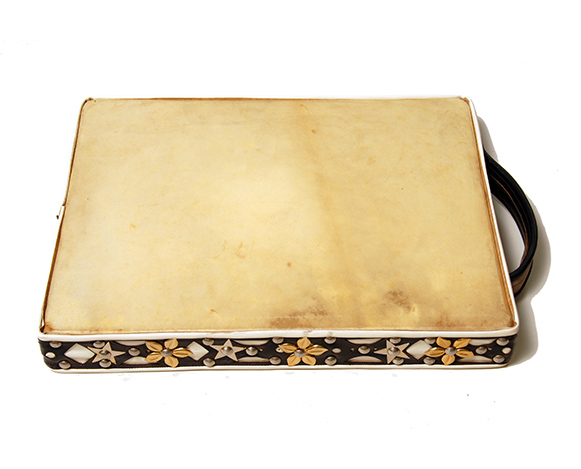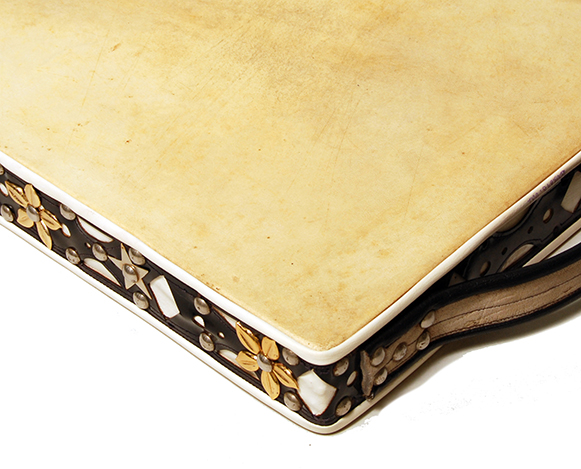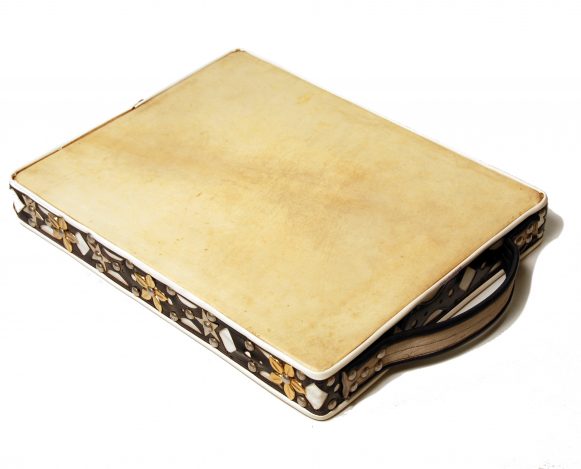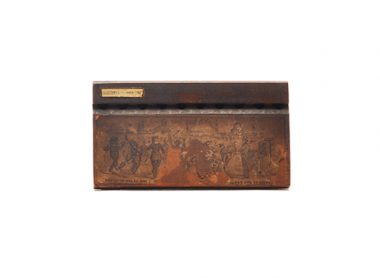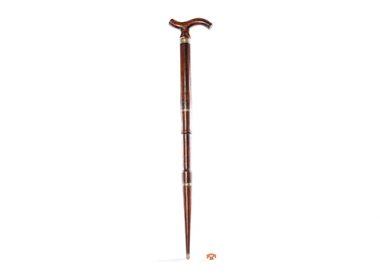Instrument: Camisão
Sound: Loose tap
Source: ANUNCIAÇÃO, Luiz D’. Os instrumentos típicos brasileiros na obra de Villa-Lobos [Typical Brazilian instruments in the work of Villa-Lobos]. Ed. bilingual. Rio de Janeiro: Academia Brasileira de Música, 2006 – Audio included in the CD attached to the book.
Instrument: Camisão (Large)
Sound: Touch stuck
Source: ANUNCIAÇÃO, Luiz D’. Os instrumentos típicos brasileiros na obra de Villa-Lobos [Typical Brazilian instruments in the work of Villa-Lobos]. Ed. bilingual. Rio de Janeiro: Academia Brasileira de Música, 2006 – Audio included in the CD attached to the book.
Instrument: Camisão (Large)
Sound: Musical phrase from Mandu-çárá, by Heitor Villa-Lobos, from the 12th bar of n. 24 (p. 33).
Source: ANUNCIAÇÃO, Luiz D’. Os instrumentos típicos brasileiros na obra de Villa-Lobos [Typical Brazilian instruments in the work of Villa-Lobos]. Ed. bilingual. Rio de Janeiro: Academia Brasileira de Música, 2006 – Audio included in the CD attached to the book.
Instrument: Camisão (Small)
Sound: Loose tap
Source: ANUNCIAÇÃO, Luiz D’. Os instrumentos típicos brasileiros na obra de Villa-Lobos [Typical Brazilian instruments in the work of Villa-Lobos]. Ed. bilingual. Rio de Janeiro: Academia Brasileira de Música, 2006 – Audio included in the CD attached to the book.
Instrument: Camisão (Small)
Sound: Touch stuck
Source: ANUNCIAÇÃO, Luiz D’. Os instrumentos típicos brasileiros na obra de Villa-Lobos [Typical Brazilian instruments in the work of Villa-Lobos]. Ed. bilingual. Rio de Janeiro: Academia Brasileira de Música, 2006 – Audio included in the CD attached to the book.
Instrument: Camisão (Small)
Sound: Loose tap in the example of the musical phrase of Mandu-çárárá, by Heitor Villa-Lobos, from the 12th bar of n. 24 (p. 33).
Source: ANUNCIAÇÃO, Luiz D’. Os instrumentos típicos brasileiros na obra de Villa-Lobos [Typical Brazilian instruments in the work of Villa-Lobos]. Ed. bilingual. Rio de Janeiro: Academia Brasileira de Música, 2006 – Audio included in the CD attached to the book.
Instrument: Camisão (Small)
Sound: Musical phrase from Mandu-çárá, by Heitor Villa-Lobos, from the 2nd bar of n. 26 (p. 34).
Source: ANUNCIAÇÃO, Luiz D’. Os instrumentos típicos brasileiros na obra de Villa-Lobos [Typical Brazilian instruments in the work of Villa-Lobos]. Ed. bilingual. Rio de Janeiro: Academia Brasileira de Música, 2006 – Audio included in the CD attached to the book.
Instrument: Camisão (Big and small)
Sound: Together in the example of the musical phrase of Mandu-çárárá, by Heitor Villa-Lobos, from the 12th bar of n. 24 (p. 33).
Source: ANUNCIAÇÃO, Luiz D’. Os instrumentos típicos brasileiros na obra de Villa-Lobos [Typical Brazilian instruments in the work of Villa-Lobos]. Ed. bilingual. Rio de Janeiro: Academia Brasileira de Música, 2006 – Audio included in the CD attached to the book.
Instrument: Camisão (Big and small)
Sound: Together in the example of the musical phrase of Mandu-çárárá, by Heitor Villa-Lobos, from the 2nd bar of n. 26 (p. 34).
Source: ANUNCIAÇÃO, Luiz D’. Os instrumentos típicos brasileiros na obra de Villa-Lobos [Typical Brazilian instruments in the work of Villa-Lobos]. Ed. bilingual. Rio de Janeiro: Academia Brasileira de Música, 2006 – Audio included in the CD attached to the book.
